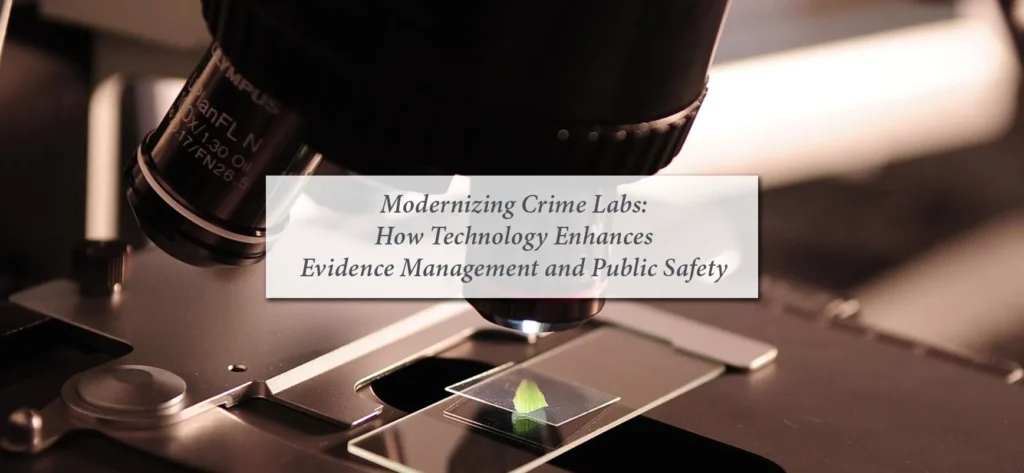In today’s fast-paced criminal justice landscape, state-run crime labs face increasing pressures. Evidence backlogs, complex compliance requirements, and outdated manual processes can delay investigations and impact public safety. Modernizing crime labs through advanced technology solutions is not just beneficial—it’s essential. Here’s how cutting-edge technology, such as automation and digital evidence management systems, can revolutionize crime lab operations and enhance overall public safety.
Challenges Facing Modern Crime Labs
Traditionally, many crime labs have relied heavily on manual procedures for evidence handling, documentation, and reporting. These methods are prone to errors, time-consuming, and often lead to significant backlogs, delayed case resolutions, and potential compliance issues. Ensuring secure, compliant evidence management aligned with stringent guidelines, such as the Criminal Justice Information Services (CJIS) and NIST standards, further complicates matters.
Common challenges include:
- Manual evidence logging and chain-of-custody tracking
- Backlogs in forensic analysis due to cumbersome paperwork
- Compliance with strict regulatory frameworks (CJIS, NIST, ISO 27001)
- Data security and privacy risks
Why Digital Transformation is Critical
Digital transformation introduces automation, integration, and transparency into crime labs. Modernizing lab processes through technology dramatically improves operational efficiency, reduces error rates, and ensures robust compliance and security.
Key advantages of digital transformation include:
- Reduced manual paperwork and administrative tasks
- Faster and more accurate evidence processing
- Real-time tracking of evidence status
- Improved compliance and data security
Key Technologies Driving Crime Lab Modernization
Power Apps for Case Management
Microsoft Power Apps enable the rapid creation of custom applications that streamline lab workflows, digitize case documentation, and ensure secure access to sensitive evidence data. Custom apps can provide:
- Digital intake forms
- Centralized, secure evidence logging
- Role-based access control aligned with CJIS guidelines
Robotic Process Automation (RPA)
Automation technology, such as RPA, significantly reduces repetitive manual tasks, such as data entry, evidence tracking updates, and compliance documentation, enabling lab technicians to focus more on forensic analysis.
RPA applications include:
- Automated evidence intake and logging
- Digitized documentation for chain-of-custody
- Real-time evidence status updates
ServiceNow for Workflow Automation and Compliance
ServiceNow provides a robust platform to automate and track lab workflows, manage digital evidence trails, and ensure strict compliance with CJIS and other regulatory frameworks. It facilitates:
- Automated case workflow management
- Chain-of-custody tracking and reporting
- Real-time compliance monitoring and alerts
Power BI Dashboards for Real-Time Reporting
Microsoft Power BI offers powerful data analytics capabilities, enabling crime labs to visualize key metrics, identify bottlenecks, and monitor evidence processing status in real-time through interactive dashboards.
Benefits of Power BI analytics include:
- Real-time visibility into lab performance
- Identification and resolution of operational bottlenecks
Enhanced decision-making with actionable insights
Ensuring Compliance and Secure Data Management
Compliance with CJIS standards, NIST security guidelines, and ISO 27001 certification is paramount for crime labs handling sensitive criminal justice information. Leveraging secure cloud environments, such as Microsoft Azure Government, ensures data protection, compliance adherence, and secure information exchange.
Real-World Scenario: A Digitally Enabled Crime Lab
Consider a digitally modernized crime lab:
- Evidence intake is streamlined through Power Apps, instantly creating secure, digital records.
- RPA automatically logs and updates evidence statuses, eliminating manual data entry.
- ServiceNow automates workflows, maintains transparent chain-of-custody records, and continuously monitors compliance.
- Lab managers use Power BI dashboards to oversee operations, address delays immediately, and manage resources efficiently.
Such modernization can reduce evidence processing backlogs significantly, minimize compliance risks, and enhance overall operational efficiency.
Benefits Realized Through Digital Transformation
By digitally transforming crime labs, organizations can:
- Accelerate evidence processing and investigative outcomes
- Reduce manual errors and administrative workloads
- Improve data security and regulatory compliance
- Enhance transparency and accountability throughout lab operations
- Increase overall public trust and safety
Embracing Technological Innovation in Crime Labs
Crime labs across various states have already begun adopting modern technologies, enhancing their efficiency, compliance, and overall effectiveness. Continuing to embrace these advancements ensures labs remain effective in handling current and future challenges.
Understanding and integrating these technological solutions helps crime labs stay ahead in an ever-evolving public safety landscape, ultimately benefiting communities by enhancing justice outcomes.
References:
- Federal Bureau of Investigation (FBI). “CJIS Security Policy Resource Center.” https://www.fbi.gov/services/cjis/cjis-security-policy-resource-center
- National Institute of Standards and Technology (NIST). “Cybersecurity Framework.” https://www.nist.gov/cyberframework
- International Organization for Standardization (ISO). “ISO/IEC 27001 Information Security Management.” https://www.iso.org/isoiec-27001-information-security.html
- Microsoft Azure Government. “Compliance in Azure Government.” https://azure.microsoft.com/en-us/global-infrastructure/government/
- ServiceNow. “Public Sector Solutions.” https://www.servicenow.com/solutions/industry/government.html

